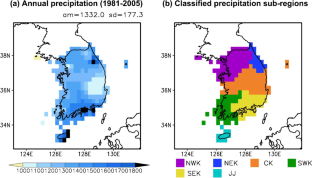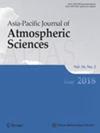Future Projections of Precipitation using Bias–Corrected High–Resolution Regional Climate Models for Sub–Regions with Homogeneous Characteristics in South Korea
Abstract
Abstract
Although South Korea has a relatively small area when compared to neighboring countries, there are large differences in precipitation characteristics by region due to its complex topography. Therefore, to effectively respond to disasters caused by precipitation in South Korea, climate change information using a climate model with an improved spatial resolution is required. This study classified sub–regions with homogeneous characteristics in South Korea using transformed gridded precipitation observation datasets. Then, high–resolution regional climate models (RCMs) with a 12.5 km horizontal resolution, which are known to simulate added value well in simulating future projections of South Korea, were bias–corrected, and future changes in the precipitation means and extremes were analyzed using these RCMs. The classified precipitation sub–regions in South Korea reasonably reflected the observed distribution of precipitation, depending on latitude and topography. The future precipitation characteristics of the classified precipitation sub–regions were predicted using bias–corrected RCMs. While the annual precipitation is projected to increase relative to the present in most grids for all future periods, the RCP8.5 scenario for the mid–twenty-first century is projected to decrease in the north of the central region. Intensified warming in the late twenty-first century is predicted to considerably increase the mean precipitation intensity and magnitude of the high–intensity extreme precipitation in all the precipitation sub–regions. As these results can lead to increased hydrological disasters, this study will help to prepare practical countermeasures for precipitation changes on regional and local spatial scales in South Korea.


 求助内容:
求助内容: 应助结果提醒方式:
应助结果提醒方式:


